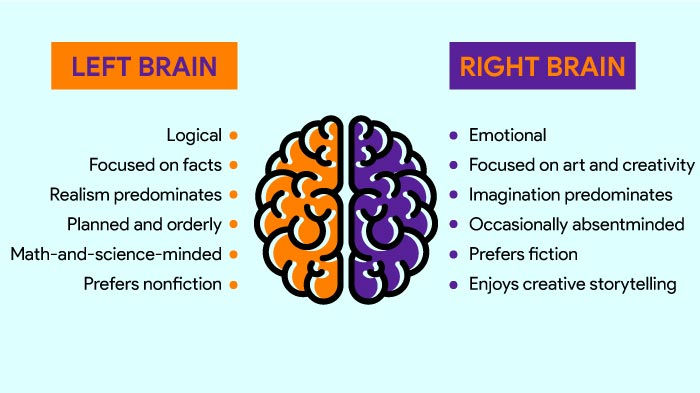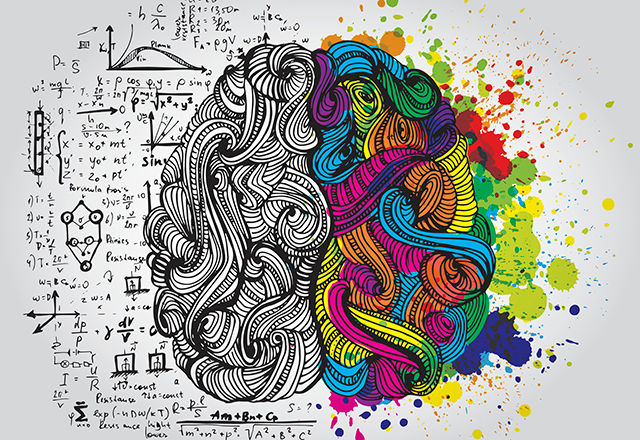The Future is Right Brained - Why?
- Santhosh Sivaraj

- Jul 29, 2021
- 11 min read

It was a Sunday afternoon, and I was getting ready to surrender myself to a cosy sofa under the guidance of some underrated boring Malayalam cinema which usually gets my attention except on Sunday afternoons. Then my phone rang. It was my childhood friend who was working for an American company from Bangalore, and now thanks to Corona, working from his newfound Airbnb home at Kodaikanal.
I was too lazy to pick up his call and yet picked it up, considering the fact that he was lazier a person than me. It seems that he has been at work without a break ever since the advent of the corona.
His remuneration has grown multifold considering the fact that he was one of the senior coders of the organisation. He said one thing which never left me. He said, "things are changing fast, Sanu. I am coding for something which is being created to replace me. Artificial Intelligence is here already."

It Is interesting to note that Corona has not only made individuals revisit their bucket list, but it also made companies rejig their way of functioning. With the advent of work from home culture, many changes are being witnessed in the corporate sector, especially the information technology side.
The objective of this blog is to address how these changes can influence the future of professions. A professional qualification today, will it be of any relevance tomorrow when AI and Robotics can replace most of the professionals' jobs?
I wanted to deliberate this blog with respect to the functioning of the Human Brain – The Left Side and the Right Side. Which side of the brain will lead the future?
The Brain

While today we know that every activity we engage in requires cooperation between the right and left hemispheres, we are also aware that each hemisphere takes the dominant role in certain activities. Generally, we can say that the left hemisphere focuses on breaking things into details, while the right hemisphere is in charge of providing the broader picture.
These differing roles can be seen, for instance, in the context of language use. Much of our language originates in the left hemisphere, where we process symbols in sequence (for example, when reading). However, the right hemisphere also plays a vital role by allowing us to take a step back from the language itself and interpret the context of the message. Without our right cerebral hemisphere, we would not be able to understand irony or metaphors.
Reasoning is another area where the hemispheres have different, complementary roles:
Responses that originate from the left are derived from what we have learned in the past. If someone points a gun at you, it's the left hemisphere that tells you to be alarmed because you have learned that guns are dangerous.
On the other hand, the right hemisphere doesn't recognize the gun, but it can draw on more intuitive knowledge and recognize other signs of danger, like an angry facial expression. The fact that all cultures tend to interpret facial expressions similarly illustrates how natural and intuitive these functions of the right hemisphere are.
The Rise and the rise of the Left Side Brain

Ever since we discovered that the left side of the brain is responsible for more analytical tasks, it has been viewed as being of greater importance than the right side.
First of all, it was once thought that because the left hemisphere allows people to solve analytical tasks, it must be the side that separates us from animals.
Second, we know that the left side of the brain controls the right side of the body, responsible for many important movements in a world where most people are right-handed and where Western language is written from left to right.
Left-Directed Thinking is thought to draw on traits from the left hemisphere, meaning it is sequential, literal, functional, textual and analytic. These traits would then also dominate a Left-Directed thinker's approach to life.
On the other hand, Right-Directed Thinking would be characterized by being simultaneous, metaphorical, aesthetic, contextual, and synthetic – all traits of Right-Directed thinkers.
Much as the left side of the brain has been appreciated more than the right, Left-Directed Thinking has been viewed as the more successful approach to life. This can be seen on a societal level – for example, in the exams students take. These exams reward linear, sequential thinking for arriving at a single correct answer in the time allotted and thus teach students to reason like computers.
Today, however, the undervaluing of Right-Directed Thinking is slowly coming to an end, as the ability to see the "big picture" is growing in importance.

The Change from Information Age to Conceptual Age
Today, we live in an era of abundance enabled by left-brain thinking.
To be successful in the Information Age, you had to accumulate a lot of knowledge, most notably by getting a college education. As this option became increasingly available to everyone, more and more people could follow this inherently left-brain method to success and become well-paid white-collar workers. Thus, the Information Age has contributed to the economic growth and rising living standards we now enjoy.
However, this situation is changing. Today, Right-Directed Thinking is becoming more and more important for a number of reasons:

First of all, certain right-brain directed aptitudes are highly prized: these are a sense for design, story, symphony, empathy, play and meaning. Someone who develops their aptitude in these areas gains a crucial competitive advantage in today's crowded marketplace, especially as left-brain intensive white-collar work is increasingly being outsourced to low-cost countries, as well as AI and robotics taking centre stage.
But Right-Directed Thinking is also gaining importance outside the office. Living in this era of abundance has made us yearn for the immaterial: we search for purpose and meaning in life, and Right-Directed Thinking is how people excel at such ambiguous tasks.
These developments are part of a change of eras as we move away from the Information Age into the so-called Conceptual Age. In this age, it is no longer an aptitude for "high tech" that is important; rather, the skills in demand fall under the categories of high concept, meaning the ability to combine unrelated ideas from different spheres into completely new inventions and high touch, meaning the ability to empathize with others.
The rising demand for these attributes can be seen in the fact that students are now taught classes on developing their creativity and increasing their empathy.
As can be seen, the move towards the Conceptual Age is happening everywhere: at school, at the office, and in our hearts and minds.
The Six Right Brain Aptitudes
In the Conceptual Age, six right-brain aptitudes are becoming essential.
They are as follows.
Design: In an age of material abundance, design has become crucial for most modern businesses.
Story: To be successful today, presenting facts is not enough; you must know how to tell stories.
Symphony: Putting the pieces together is more important than taking them apart.
Empathy: As computers take over more and more tasks, abilities unique to people, such as empathizing with others, become more important.
Play: Light-heartedness will likely play an ever more important and beneficial role both at work and outside work.
Meaning: Now that our material needs are met, we search for meaning, purpose and fulfilment in life.
The Design

Today, good design is more important than ever. This is because people are more aware of what constitutes good and bad design. For example, these days, most people can easily distinguish between different fonts like Times New Roman and Arial, but just 20 years ago, only typesetters would have been aware of such knowledge.
For example, a poorly designed ballot during the US election in the year 2000 confused so many voters that it is likely the outcome of the election would have been different if the ballot had been better designed.
Also, research indicates that improving the design of a school's physical environment can increase students' performance.
This trend means that product design has become a crucial aspect of businesses. It is no longer enough to produce functional products at a reasonable price; customers demand good design.
This trend can be seen in such trivial objects as kitchen utensils: bottle openers now come shaped like animals, and spoons may have faces imprinted on them.
Research at the London Business School shows that for every per cent of sales invested in product design, a company's sales and profits rise by an average of 3 to 4 per cent.
Story Telling

Throughout history, telling stories has been an integral part of the human experience. We tend to remember stories far better than individual facts, and we also tend to see our lives as stories: they begin somewhere and unfold from there in a particular direction. Looking at life as a story gives us a sense of purpose and meaning.
In the Information Age, factual knowledge was very important: knowing more than others allowed you to stand out from the crowd. Yet nowadays, as we move into the Conceptual Age, facts can be accessed easily online, so knowledge has become less relevant.
Instead, what is essential is an aptitude for a story: the ability to place facts in context and deliver them as a story.
Indeed, in various fields of business such as advertising and consulting, telling a story is crucial to success.
Similarly, the ability to understand and tell stories is becoming increasingly important for doctors. Nowadays, many medical schools are offering their students courses in the humanities to become more sensitive to the stories their patients tell.
Telling stories has also become a fundamental way for companies and individuals to make their goods and services stand out in a crowded marketplace. This is because people think of their lives as stories, so they also find it easier to relate to companies and products if they hear about them as stories, not as a series of facts.
There is even a movement called "organizational storytelling," where organizations collect the stories their employees tell so that the company has relatable human stories to share. For example, rather than relying solely on manuals to train their technicians, Xerox collects all the stories their technicians tell about repairing machines and passes them on for others to learn from.
These phenomena demonstrate how, in the Conceptual Age, storytelling is becoming more important than ever.
Symphony

In the past, what was important in most jobs was the ability to acquire knowledge. Typically, this was done by looking at a complex topic, taking it apart and memorizing the individual pieces of knowledge it consists of. This approach is also emphasized by the modern education system: disassemble and memorize.
But today, as knowledge is widely available (for example, online), it is no longer necessary to store individual facts in your memory. Instead, what has become important is an aptitude for the symphony: combining individual elements and putting them together to form something greater, much like a composer or conductor does with music.
This is because, first of all, we live in a very diverse age, and people who can combine expertise from multiple cultures and languages are better suited for such an age.

Second, the life cycle of a new product is becoming increasingly short: yesterday's innovation is tomorrow's near-obsolete commodity. This means companies must constantly innovate, and the best innovators are those able to combine unrelated ideas and thoughts into something new. For example, when George de Mestral saw how burdock seeds stuck to his dog's fur thanks to the tiny hooks that covered them, he realized he could use something similar to bind materials together. This led him to invent Velcro.
The aptitude for symphony also helps people see the big picture instead of the individual parts, bringing both success and happiness.
Empathy

Many of the jobs that existed in the Industrial Age and Information Age are increasingly being taken over by computers and machines – for example, assembly-line work and data analysis.
In the face of this development, it is comforting to know there are some tasks that computers will never be able to do. While any work that can be reduced to a set of rules that must be followed can be given to machines or outsourced to other countries, tasks that demand a deeper understanding of the subtleties of human interaction are more immune to such developments.
At the core of such tasks is empathy, which is essential in a variety of fields.
For example, think of lawyers: whereas legal research could be done by intelligent algorithms or lawyers elsewhere globally, the crucial part of a lawyer's job – to empathize with clients and understand their needs – is irreplaceable.

Similarly, physicians cannot be substituted by computers because computers do not feel empathy, and patients want their doctors to empathize with them. In fact, empathy is increasingly being recognized as an essential part of healing.
Not only is empathy important in the professional sphere, but it is necessary for understanding others in general. Empathy is a universal language, and research has shown it is communicated mainly through universally understood facial expressions. Also, an aptitude for empathy supports and enables other aptitudes, like design and story, as it helps you to see things from another person's perspective.
The good news is that everyone can learn to become more empathetic. For example, at Stanford Business School, students are already taking classes in "interpersonal dynamics." Likewise, people from government agencies like the FBI and CIA receive training in reading facial expressions, the language of empathy.
Play

You may have heard that one should not mix business with pleasure or work with play. But today, introducing elements of play, meaning humor and lightheartedness, into all areas of life is not only more common but necessary.
To understand how much more prevalent the element of play is, consider the vast industry that has grown around video games. They are now an essential part of the lives of young Americans, with half of the population over six years of age playing video games.
This increased tendency to play has brought with it some positive influences. Research has shown that video games can promote skills vital in the Conceptual Age. For example, the most popular video games are role-playing games (i.e., simulation games), improving players' aptitude for empathy.

Another element of play, humor, is becoming increasingly valuable in the world of work because humor reduces hostility, deflects criticism, relieves tension, improves morale and helps communicate complex messages.
And which side of the brain is humor generated in? On the right side, because humor requires skills specific to it: placing situations in context, seeing the big picture and seeing things from new angles.
At the same time, this newfound joyfulness is likely to make us more productive and fulfilled – both in private as well as professionally. For example, research has shown that laughter decreases stress hormones and boosts the immune system and that playing video games at work can increase productivity and job satisfaction.
Meaning

Most people feel the desire to seek some meaning in their lives; it is a fundamental drive-in humans and has become one of the essential aptitudes of the Conceptual Age.
Nowadays, with ageing populations and the constant threat of terrorism and increasing prosperity, thanks to technological advancement, spiritual and immaterial concerns are becoming of profound importance to people.
This means that spirituality, the search for the higher meaning and purpose of life (for example, through religion), has recently become increasingly important – both in business and in private life.
This is exemplified by the fact that employees today increasingly want to experience greater spirituality at their workplaces. The rise of new businesses like yoga studios and "green" products also demonstrates how spirituality and the new emphasis on meaning affect the business landscape.
Similarly, increased spirituality is impacting our health. Studies have shown it can improve maladies and it reduces the risk of suicide. It has even been found that people who regularly go to a place of worship like a church, mosque or synagogue live longer than others.
These effects are why many medical schools now have courses on spirituality and why many physicians take some form of the spiritual history of their patients.
Of course, the pursuit of meaning is strongly connected to the pursuit of happiness. While happiness is derived from a mix of biological and environmental factors, people who find meaning in life are also the most likely to be happy.
Conclusion

Society is on the brink of a major change when it comes to the concept of professionalism. Thanks to technology, expert knowledge, now digitized and disseminated online, is far more readily available to the layperson. That doesn't render professionals obsolete; it just means their roles are changing.
Professional expertise will always be important, as today's mass of knowledge cannot be mastered by a single individual alone; technology is the tool that will help us all get ahead.
As technology peaks, we begin the journey from the information age to the conceptual age. With the advent of the conceptual age, the right brain aptitudes are becoming more critical.
Being innovative, creative and empathetic are traits that help us succeed professionally while also increasing our personal well-being. While left-brain thinking is still important, it is insufficient on its own.




Comments